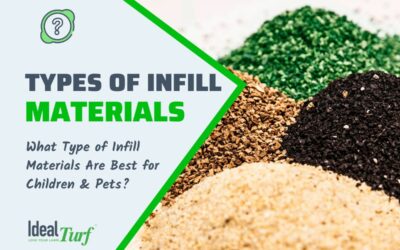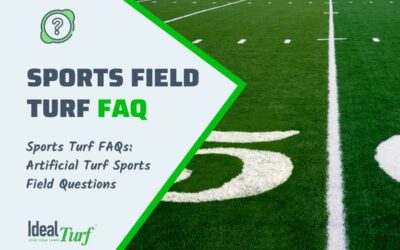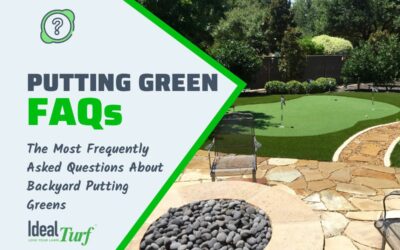Pet Turf Odor Removal Guide: How To Remove Dog Urine Smell From Artificial Grass
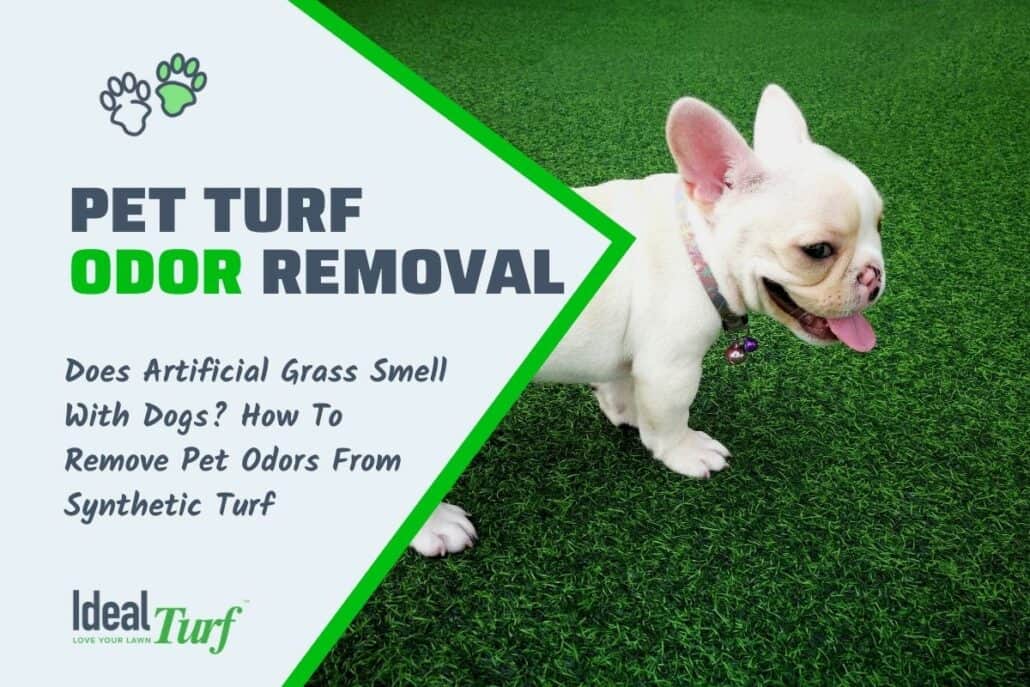
Artificial grass is beautiful, convenient, and durable.
It doesn’t require fertilizer, weeding, watering, or mowing.
It’s weather-proof and pest-proof.
Perfect pet turf, right?
In many ways, yes.
Artificial grass withstands a lot of wear and tear, and basic cleaning requires only a hose and spray nozzle.
But when it comes to dogs, urine can create a real problem.
The smell isn’t immediately apparent, but dogs are creatures of habit.
They tend to urinate in the same general area repeatedly, which allows odors from the urine to build up over time.
Fortunately, pet turf odor removal is a relatively simple process.
If it wasn’t, then fake grass for dogs wouldn’t be so popular amongst home and business owners.
In this article, we’ll explain the causes of dog urine odors in artificial grass, how to remove odors and smells, and how to properly maintain pet turf.
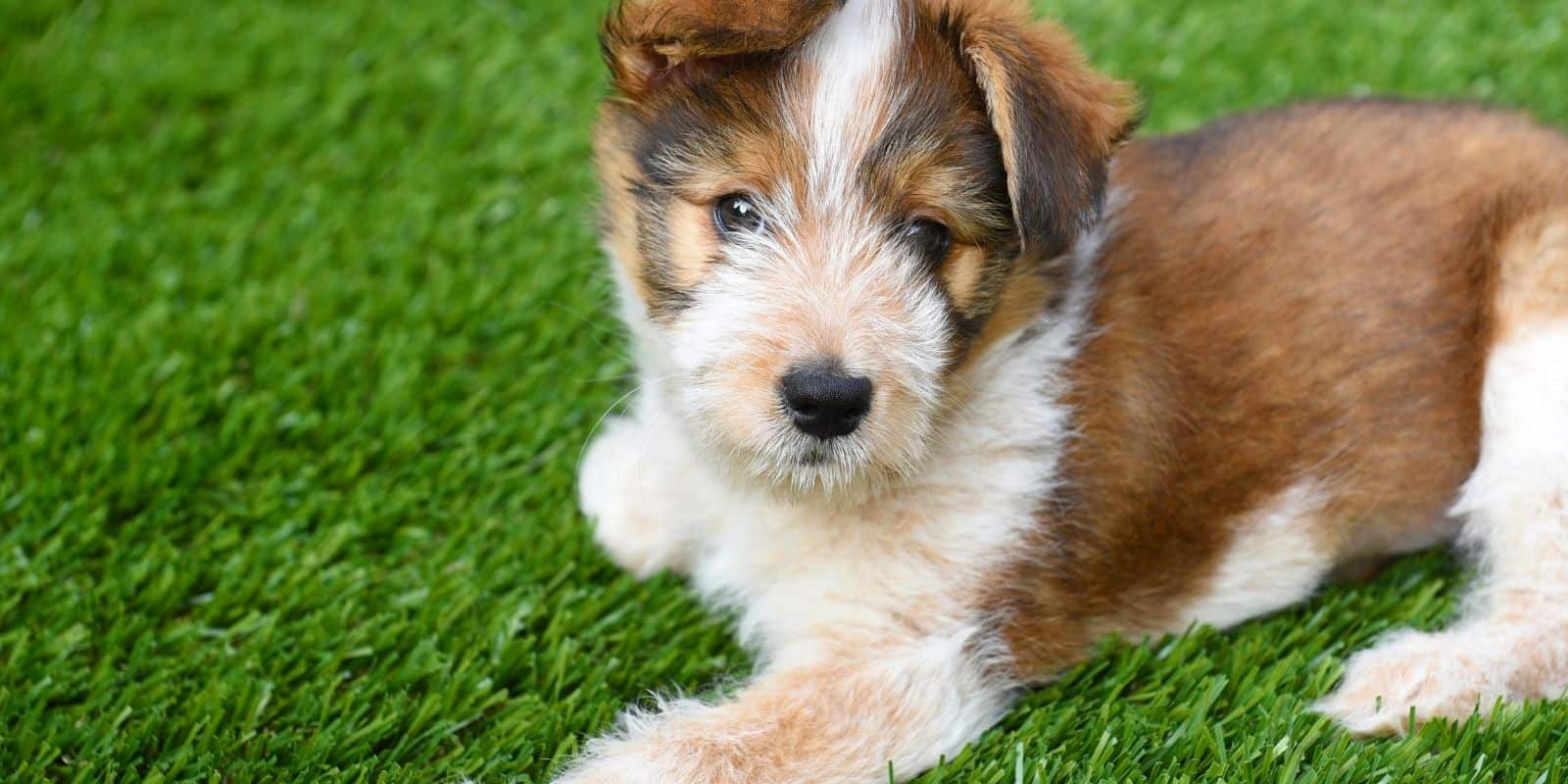
Why Does Dog Urine Make Artificial Grass Smell?
Before going into pet turf odor removal, we’ll explore why dog urine makes artificial grass smell.
Then we’ll outline proper maintenance for pet turf and review ways you can help minimize dog-related problems with your artificial grass.

Poor Drainage
Artificial grass usually drains liquids better than natural grass, which is why it’s so popular for pet relief areas.
However, poorly installed turf can erase this advantage.
Your grass can only be as good as its base.
For example, placing the weed membrane directly under the grass instead of underneath the foundation will absorb and trap urine and other liquids.
Installing a base that doesn’t include a layer of aggregate topped by a layer of ground rock can restrict drainage and cause water and urine to stay near the surface rather than soaking through.

Lack of Care and Maintenance
In addition to removing any solid waste at least once a day, artificial grass used as pet turf needs to be rinsed down with a hose at least once a week.
Although this does not entirely take care of the problem, using water will rinse the surface, remove dust that can absorb urine, and slow down the build-up of odors.
Additionally, the artificial grass should be swept or raked periodically to remove debris and fluff the fibers.
Small debris that’s ignored can make its way between the turf fibers and potentially inhibit drainage.

How to Combat Odors and Smells in Pet Turf
Pet urine is 95% water.
The other 5% – a combination of uric acid, urea, ammonia, proteins, salts, minerals, and toxins – creates the problems.
Uric acid is made of microscopic crystals that don’t dissolve or decompose themselves.
That’s why the odor stays around for weeks, if not months, if you don’t take steps to neutralize it.

Preventing Odors from Dog Urine in Artificial Grass
Odor prevention for pet turf begins in the selection process, even before the artificial grass is installed.
Dog-friendly artificial grass includes features specifically designed to prevent the buildup of odor-causing bacteria.

Efficient Drainage
Dog-friendly pet turf’s most important feature is its drainage efficiency.
You want your dogs urine to pass through your artificial grass installation as quickly and completely as possible.
The majority of modern pet-friendly turf products are equipped with a 100% permeable backing that’s fast-draining.
It provides efficient, edge-to-edge drainage capacity.
A lot of turf suppliers and installers offer pet turf products with a proprietary drainage system.
From what I’ve seen, they’re all essentially the same thing with a different name.
Pet owners make up a significant portion of our customer base and we want to offer the best turf products possible, which is why we developed our own turf drainage system.
It’s a hybrid backing that’s 100% permeable and hole-punched that we call Dual-Flow™.
That may seem counterintuitive, why would you punch holes in something that’s fully permeable?
The holes are meant to allow small debris and residual fecal matter from your dog to more easily pass through the turf.

Antimicrobial Protection
Advancements in technology and manufacturing techniques have led to some great innovations in artificial grass.
One of the most significant advancements for pet-friendly artificial turf is the infusion of antimicrobial protection.
Antimicrobial additives are infused into the turf product during manufacturing.
Once incorporated into a turf product, the antimicrobial protection lasts the lifetime of the turf.
That means that in 20 years, your pet turf installation will still have the same level of antimicrobial protection it had on day one.
Not only are antimicrobial additives 100% safe for pets and children, but they help prevent the buildup of bacteria, mold, and mildew.
Our pet-friendly artificial grass products are equipped with a proprietary antimicrobial additive that’s infused into the backing.
We chose to add our “Microbe-Safe™” antimicrobial additives to the backing because that’s where your dogs urine will build up the most.

Infill Material That’s Pet-Friendly
Infill is a material placed between artificial turf fibers (synthetic grass blades) to help them stand up and return to the normal upright position after exposure to pressure.
Infill also helps shield against UV damage.
There are several kinds of artificial grass infill, including rounded silica sand and a patented, temperature-reducing material called ToCool® Infill.
We recommend ToCool® for pet turf.
In addition to reducing the surface temperature by 30oF to 50oF through evaporative cooling technology, ToCool® is coated with antimicrobial agents.

How to Maintain Artificial Grass for Dogs
In general, the need for artificial grass maintenance is practically non-existent.
Caring for and maintaining pet-friendly artificial turf involves a little more effort, but it’s not time-consuming or difficult if you follow best practices.
If you had artificial grass installed in your dog run, we published a guide on dog run cleaning & maintenance that you may find helpful.
Below are the steps involved in maintaining artificial grass for dogs.

Pick Up Solid Waste
Remove solid waste at least once daily.
This may seem like a no-brainer, but there is a procedure for removing solid waste.
Most importantly, let it dry before trying to pick it up so that the waste is not accidentally smeared onto the grass blades or backing.
If solid waste smears, rinse it off thoroughly as soon as possible to avoid staining and increased odor buildup.
If simple rinsing doesn’t work, use mild soap and warm water with a brush or disposable paper towel, and then rinse again.

Rinse Turf Regularly
The best artificial turf cleaner (not to mention the least expensive) is rain.
But even if you live somewhere that gets lots of rain, you should rinse your grass yourself if a week has passed without a soaking rainfall.
Pet turf should be sprayed with a nozzle-equipped garden hose to rinse away dust, dirt, and pet urine.
If used by your dog every day, once a week is a good frequency.
If you have multiple dogs or are having particular problems with odors, you will want to consider rinsing it every couple of days or even as often as once a day.
Pay special attention to spots that the dog uses the most.

Pick Up Debris
Pick up any debris, such as leaves, twigs, rocks, and other material, as soon as practical after noticing it.
Debris can damage your artificial grass and interfere with proper drainage by creating holes and tears and from the decomposition of organic materials.
Leaf blowers are very helpful in getting leaves and other debris off your turf, but make sure you use the blowing end, not the vacuum end, as vacuum suction can pull up the infill materal.

Clean Stains Promptly
As mentioned above, address stains with a mixture of mild soap and warm water, applied with a brush or disposable paper towel.
Finish with a pet-friendly deodorizer and disinfectant, or use equal parts vinegar and water.
Let the mixture soak into your pet turf for 15-30 minutes, then rinse thoroughly.
Never use harsh chemicals or solvents to clean spills, stains, or sticky substances from your pet turf.

Remove Weeds
Although artificial grass is installed with a weed barrier, turf products with a hole-punch backing occasionally experience breakthrough growth.
If you prefer, you can spray into the hole with a pet-friendly, non-toxic weed killer after removing the growth.
Weeds can also sprout from seeds that fall onto the turf surface from trees or passing birds.
These are very easy to remove because they cannot form a solid root system through the turf backing.

Fluff Turf Fibers
Artificial grass fibers don’t on their own stand upright like natural grass.
Faux grass fibers are directional, like fur, and they require a little assistance to stay upright.
The infill material that’s added during installation does most of the work in keeping turf fibers upright.
Heavy foot/paw traffic and objects placed on the turf can cause matting of the fibers.
Luckily, this is simple and easy to fix.
The best tool for the job is a stiff-bristle push broom with bristles at least 5 inches long.
Be sure not to use wire or metal bristles, which can damage your turf.
Working against the grain, brush or rake your grass fibers to fluff them up.
This redistributes the blades, so they last longer and wear more evenly.
It also makes your artificial turf look more like natural grass.
For best results, do this as often as you notice the need or about once a month, whichever comes first.
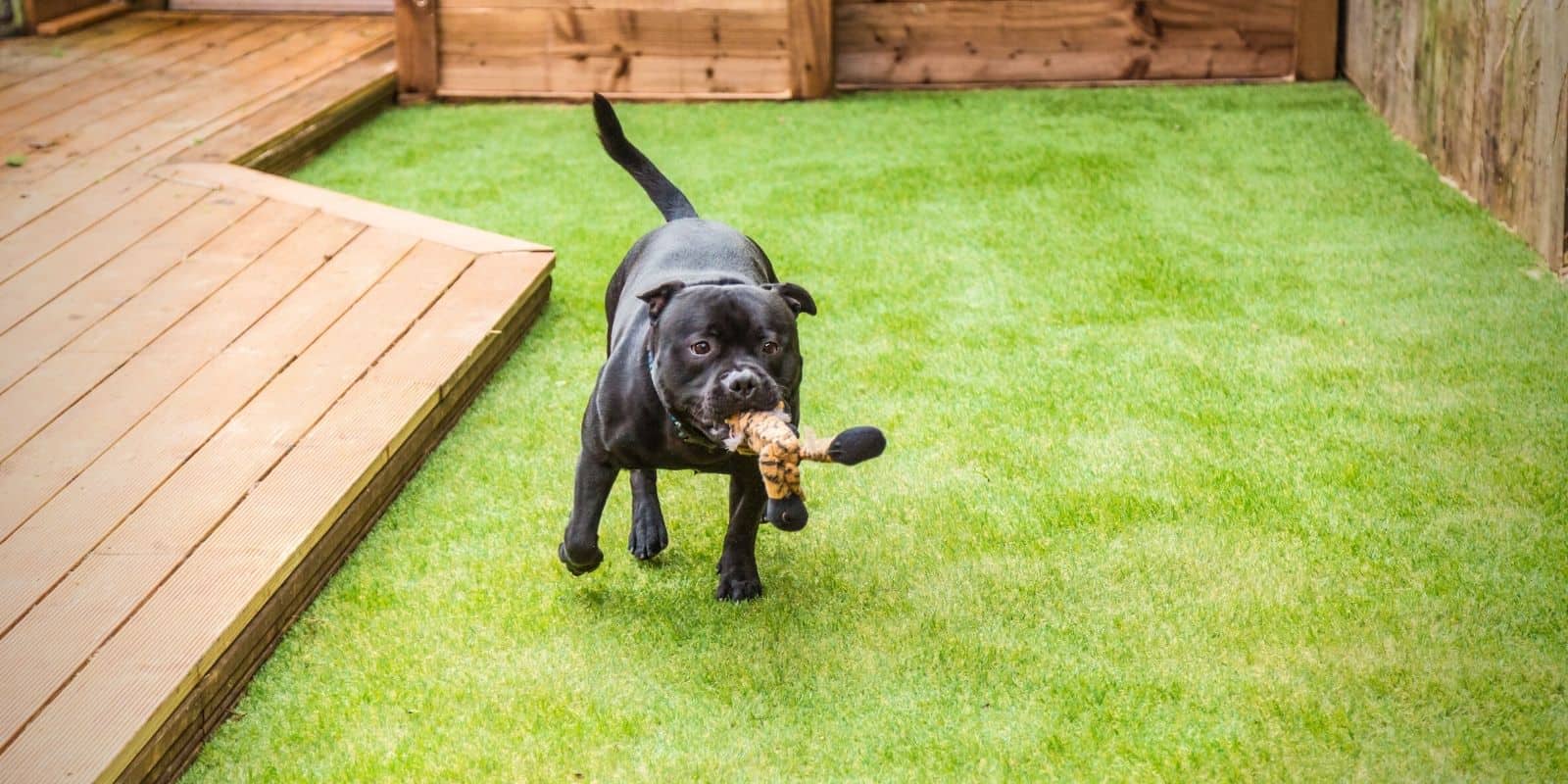
Pet Turf Odor Removal: How to Remove Urine Odor from Artificial Grass
Urine odors can take all the fun out of having a beautiful artificial lawn for your family, friends, and pets to enjoy.
The problem can be especially bad during warm weather months.
The good news is that removing dog urine odor is easily achievable when using the correct cleaning formulations, whether commercial or homemade.

Pet Turf Odor Removal with Commercial Turf Cleaner
Numerous commercial products on the market are expressly designed to remove urine odor from artificial grass.
Most are enzyme-based, “green” formulations that penetrate the turf surface and continue down into the filler material and base substrate, moving along the same path as the dog urine.
Make sure that you choose a commercial formulation that is 100% pet safe, low-suds, and biodegradable and contains no alcohol or harsh acids.
Remove any solid waste or debris and apply the cleaning product as a spray under low to moderate pressure.
Thoroughly saturate the area and then let sit for 10-15 minutes.
In stubborn spots, you may want to scrub gently with a soft-bristled brush or turf broom before starting the soaking period.
Rinse thoroughly with the hose nozzle on the sprayer setting and allow to dry.
Repeat the process if you notice any odor before the lawn is used again by your pet.

Pet Turf Odor Removal with Homemade Cleaner
To make your homemade odor remover, combine 1 part distilled white vinegar, 1 part water, and a few drops of dish soap.
Shake or stir and spray on the stain as you would a commercial cleaner.
Many people sprinkle baking soda on their artificial grass before using the vinegar mixture in order to intensify the deodorization process.
Cover the smelliest areas with a large amount of baking soda and allow it to sit for a couple of hours or even a full day.
Pour the vinegar mixture on top of it, which will create a foam, then proceed with the remainder of the cleaning process.
The cleaning process for a homemade cleaner is the same as with a commercial cleaner.
Remove any solid waste or debris and apply the cleaning product as a spray under low to moderate pressure.
Thoroughly saturate the area and then let sit for 10-15 minutes.
In stubborn spots, scrub gently with a soft-bristled brush or turf broom before soaking.
Rinse thoroughly with the hose nozzle on “spray” and allow to dry.
Repeat the process if you notice any odor before the lawn is used again by your pet.

Final Thoughts on Pet Turf Odor Removal
Nothing beats the beauty and convenience of artificial grass, especially when trying to create a dog-friendly backyard or purpose-built dog run.
Following best practices for product selection, regular maintenance, and pet turf odor removal, you can expect many years of no-hassle enjoyment from your pet turf investment.
Contact Ideal Turf today for a free, no-obligation estimate or give us a call at (800) 204-4650.
Recent Posts
- How Does Artificial Turf Help With Allergies Compared to Natural Grass?
- Artificial Turf Innovations & Advancements: The Future of Synthetic Grass
- The Top 10 Best Artificial Turf Backyard Putting Green Installers in & Around Lubbock, TX
- Types of Infill Materials Used on Artificial Turf: Which Infills Are Best for Children & Pets?
- The Top 10 Best Artificial Turf Backyard Putting Green Installers in & Around Oklahoma City, OK

